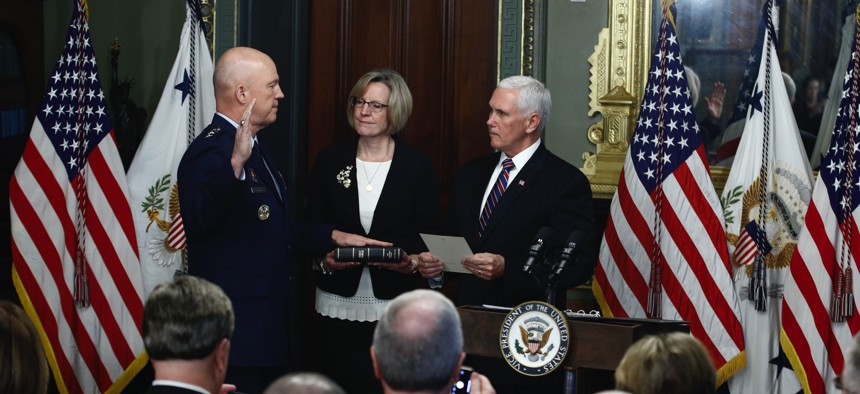
Vice President Mike Pence, right, swears in Air Force General John Raymond as Chief of Space Operations, as his wife, Molly, center, holds a bible in the Ceremonial office at the Executive Office Building, Tuesday, Jan. 14, 2020, in Washington. AP / Steve Helber
Last month, not long before boarding a plane to Mar-a-Lago for Christmas, President Trump signed legislation that created the newest military branch in the United States in more than 70 years: the Space Force.
Between the holiday season and more pressing military news, the creation of the Space Force did not initially make a big impression. But the president seems pleased with his newest armed service. “Everybody’s excited about that,” Trump said at a campaign rally in Ohio last week. The crowd responded with boisterous chants of “U-S-A.” Vice President Mike Pence celebrated “America’s heritage as the world’s greatest spacefaring nation” yesterday, as he swore in General Jay Raymond as chief of space operations. The new organization even has its first controversy: Over the weekend, military officials brought a Bible to the Washington National Cathedral to be blessed for swearing-in ceremonies of Space Force officers, raising objections about the coziness of church and state.
But what will the Space Force actually do?
Trump has pushed for the creation of the Space Force since the spring of 2018. But the version that became law isn’t exactly the one he might have in mind. Yes, the law, part of a larger defense-spending bill, established the Space Force as the sixth branch of the American armed forces, but it is not the stand-alone organization that Trump seemed to have promised, a “separate but equal” entity alongside the Air Force—a problematic framing for different reasons—the branch historically responsible for defending the country’s space interests.
Related: Space Force Is Go for Launch, But ‘Thousands’ of Decisions Remain
Related: The US Air Force Has Won Control of the Space Force
Related: US Space Force Lists 20 Tough Problems for 1st Pitch Day
The new Space Force instead exists inside the Department of the Air Force, in an arrangement similar to that of the Marine Corps and the Navy, which both operate under the Department of the Navy. There will be no secretary of space: As space ops chief, Raymond now holds the organization’s highest position. The law also stipulates that the Space Force must be built from existing personnel in the Air Force, and does not have the authority to hire new people. The Space Force has simply absorbed the Air Force unit that focuses on space operations, the Air Force Space Command, which was established in 1982. Its members will remain Air Force officers, but those with space-related roles will become Space Force officers in the next year and a half.
The creation of the Space Force so far amounts to little more than bureaucratic reorganization, which probably wouldn’t prompt a chorus of enthusiastic cheers without such a flashy name. “All you’re doing is reshuffling the deck chairs,” says Richard Wolf, the director of the Air Force Historical Support Division, who provided historical information to Trump administration officials about the last time the U.S. set up a new military branch—the Air Force—in 1947.
The prospect of a Space Force has been hazy since Trump first mentioned it, mostly because the proposal seemed to be a passing thought. “I was saying it the other day—’cause we’re doing a tremendous amount of work in space—I said, maybe we need a new force. We’ll call it the Space Force,” Trump said back in 2018, to an audience of marines. “And I was not really serious. And then I said, what a great idea. Maybe we’ll have to do that.” The name called to mind images of space cadets pew-pew-pewing at enemies with plasma beams, and the suggestion became catnip for late-night-television hosts and the subject of an upcoming workplace sitcom from Steve Carell.
The reaction exasperated those in the national-security community who actually think some version of a Space Force is a good, and even long overdue, idea. “It does make sense that we’d be heading in that direction, considering how much more space is meaning to our military operations now,” the space analyst Laura Seward Forczyk told me. Security experts are divided on how the United States’ space capabilities compare to other spacefaring nations like Russia and China, but they wouldn’t turn down increased emphasis on militarized space in some capacity.
The Space Force is not a Trump invention, as many have assumed. The concept has been floating around since the 1990s, since the Gulf War showed the growing utility of satellites in ground combat. In 2001, a report from a commission chaired by former Defense Secretary Donald Rumsfeld recommended the U.S. create an armed service dedicated to space and keep it inside the Air Force. The suggestion was forgotten a few months later, in the aftermath of 9/11.
The concept showed up again in 2017 in bipartisan legislation in the House, which proposed the creation of a space corps, but the bill failed to gain approval in the Senate. Even Trump’s Pentagon officials, including former Defense Secretary Jim Mattis—who has since resigned—opposed the idea, saying that it would only introduce more bureaucracy in an already complex organization structure. (They quickly reversed their stance once the president expressed interest.)
Trump has presented the Space Force as something unprecedented, especially during rallies, and his administration saw an opportunity in the applause lines that always came. In the summer of 2018, the president’s campaign team sent an email to supporters chock-full of colorful logos for the future Space Force and invited them to vote for their favorite. One reimagined NASA’s logo, while another declared that “Mars Awaits.” (NASA, a civilian agency, doesn’t work on military space programs.) After clicking, supporters were delivered to a page seeking donations for Trump’s reelection.
The intent was clear, as my colleague David Graham wrote: “The Trump campaign appears to be selling the logo rights to the Space Force in exchange for campaign donations, turning the government into a tool for Trump’s own political enrichment.” It was a bold move considering the Space Force did not yet exist.
The immediate future of the Space Force involves a lot of paperwork and a dash of symbolism, rather than new uniforms and fight songs. Raymond will join the Joint Chiefs of Staff, the military officials who advise the president directly, and the service must come up with and submit an organization plan to Congress in February.
While the Space Force is now official, a slight disconnect in reality remains. “Join us as we watch history in the making. First launch of US Space Force!” the branch’s Twitter account announced earlier this month, with a link to a livestream of a SpaceX launch of its internet satellites. It was an accurate statement, in one way: The 45th Space Wing, the Air Force unit that oversees launches from Cape Canaveral, has been reassigned to the Space Force. But aside from the rebranding, there was nothing different about the mission.
Defense officials say the Space Force will become fully operational by 2024. Until then, it will no doubt remain one of Trump’s favorite namedrops on the campaign trail, a move that may jeopardize the new force’s future. Bipartisan policies—which the Space Force used to be, for the most part—have the best chances of surviving White House transition. (Most Democrats opposed the creation of any kind of Space Force, but they only got on board after the White House promisedmore parental-leave benefits for federal workers in exchange.) “When the president got involved and made this a campaign rallying cry, it became political,” Forczyk said. The next president may see fit to roll back the young Space Force, logos and all.




